1960's
Already married by the time he took office as President of the United States of America, John F. Kennedy more than any other figure haunted and inspired the decade of the l960’s. J. F. K. exuded confidence and intelligence unlike any president in the last half century. Jackie, meanwhile, became an icon for many when wearing her wedding dress.
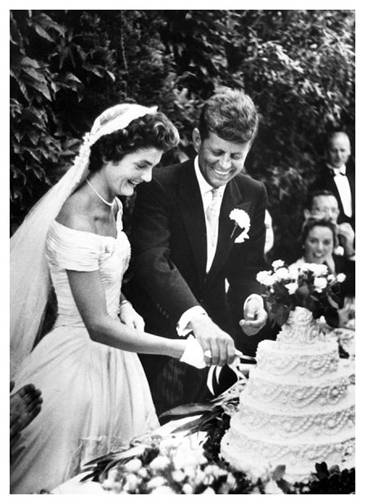
It was during the Kennedy presidency that America entered the Vietnam War. But had he lived would Kennedy have been so reckless as to send millions of Americans there, where fifty thousand were to die? But we will never know.
In his first months in office he continued a plan devised in the Eisenhower administration which involved landing “Cuban troops” sponsored by the CIA to invade Cuba; all of them were soon captured if not killed. Thereafter, in l962 a chilling stand off took place with Premier Khrushchev of the Soviet Union and the Kennedy administration regarding Russian missiles in Cuba, which were within range of many American cities on the Southern and Eastern Coasts. Only one year later in Dallas, Texas on November 22, l963, Kennedy was assassinated.
1. My own courtship and wedding took place against that background in the early l960’s.
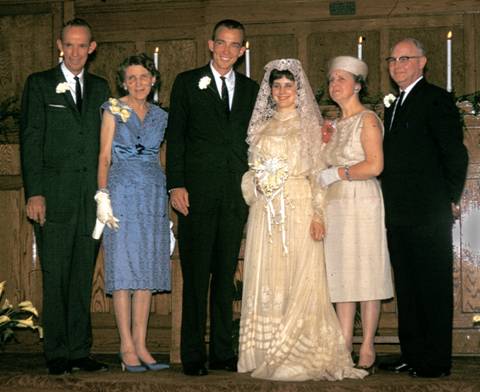
On June 18, l961 I married Helen Rank in the Methodist Church in Humboldt, Iowa. I cannot, like many others in 'the album project" remember many details of the wedding ceremony. I do recall that we had a traditional ceremony of the Methodist “persuasion” and were allowed few alterations.
It is easier to remember our first meeting in July 1959. We met on a tennis court in Princeton N. J. where Helen had gone to play tennis with a friend, as recorded in her journal, the day was “warm, bright, golden…when (we) picked up tennis balls with the intention of burning up some extra calories…”
Meanwhile I had gone to the same tennis court with a classmate from my Hebrew class. When I think of how accidental such a meeting seems. No one arranged our meeting, but because we both appeared the same hour on the same dirt court the course of our lives was changed, even though we were there for 10 minutes together. One of her balls went into my court, so as I handed it to her, she said, "We have to go now." At that moment my classmate asked, “Do you have anything to drink?” Both girls look surprised, but after about ten minutes she and her friend, came back with some iced tea. They said that they would have brought beer, but since it was a Princeton Seminary Court, they were afraid we would not drink beer.
In gratefulness for the iced tea, I asked them to join us for a meal somewhere, to which she responded, "I know a Chinese restaurant where you can get enough for two on one order!" Her friend and my tennis partner disappeared in the proceedings, and only the two of us went to the Princeton Tea Garden. We ordered on meal, but the smart waiter brought two plates.
As we left the Tea Garden I told her that I was expecting a friend to come for the weekend, but my friend was always late, so we could talk in my room in Hodge Hall until he came. She was shocked for that was not possible at Iowa State University. “An unheard of invitation to this child from the Midwest. But she replied in a casual “I think it could be arranged.” …. (Helen Rank, unpublished journal August l959)
I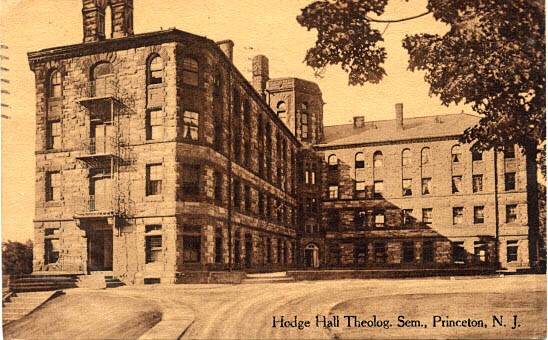
--www.rootsweb.com-~usgenweb-nj-mercer-postcards-hodge-s.jpg.jpg.
Imagine a first date going this old building—Hodge Hall, Princeton Seminary Campus!
What is it that makes an accidental meeting turn into a marriage? Most folks I interview can remember their first meetings more than what they said at a marriage ceremony, or even who was present, if the photos are not still extant. The next time we met was by design, for even in a small town like Princeton, we might never have met again, since she worked during all meal time hours as a waitress in the Princeton Inn, and I only came out at meal times from my classes and study. Indeed, I was overly serious learning the Hebrew Language, even though I did not know that the study of Hebrew would be a life long pursuit and I would teach Hebrew for thirty years. I told Helen, for by then I had learned her name, that we should have a date for a walk to a quiet lake and read a couple of books.
The next day she showed up with Three who Made a Revolution, by Bernard Wolfe. I was impressed! She had already started to read the well marked up book, so I was quite impressed, since I not as yet read the book, even as a history major. Moreover, she had very thick glasses, which to me that she must have read a lot before. Now after 40 years she is still reading, and I am still studying Hebrew.
We read more afternoons that summer, including Archibald MacLeish’s “JB.” Then later in the summer we took a train to New York to see the dramatic version. We seemed to have some common interests. In future years, talking with folks who want a wedding ceremony, I often asked, “What will you have in common. What hobbies do you share? What values do you affirm/”
“Back to the Fifties,” from August 1959, Helen went back to Iowa, and I took a ship to Southampton and a train up to Edinburgh, to study there on the second year of the divinity degree.
All through that year she wrote a letter, almost every day, for the year we were apart. She also composed some lines in her dairy that she later shared. For example, on July 6, soon after we met, she asked herself, “stop thinking about that southern fellow…yes, he is nice, but this (is) just summer; he leaves for Europe, I leave for Iowa; no see, no more, do summer affairs ever emerge into winter loves? Question, questions, questions…”( Helen's unpublished journal)
I went to Scotland for a year of study toward my divinity degree, but as soon as my ship landed from Europe in Charleston, South Carolina, I headed for Iowa in August of 1960 in a new black Volkswagen. There I met Helen’s family for the first time. It seemed inappropriate to ask her family formally if they would accept me as a suitor; but I waited for a moment which never came. I went back to Yale for my last year.
When Christmas vacation came, I got a ride to Iowa from a classmate back at Yale Divinity School; this time I did ask both her mother and father for “the hand of their daughter.” The reactions were not quite as I expected, but that is another story. So here I will just include what I would consider the moment of betrothal.
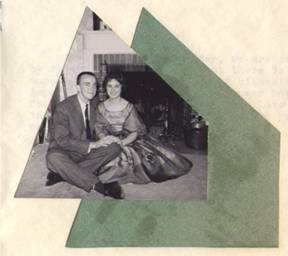
The image above comes from the scrapbook which Helen made as we sat in front of her family fireplace in December 1960, when it was clear to us, if not to her family that we would be married the following June. Until the wedding might take place in June, I spent my final semester at Yale Divinity School a thousand miles away from her hometown; meanwhile, she was in her last semester at Iowa State University.
In March during spring vacation, I drove my VW to Iowa again, this time leaving the car for her to use to arrange our wedding in June. We thought we needed to buy wedding rings that March; so we went to several jewelry stores in Des Moines, but we saw nothing that appealed to us. When she was holding up one ring, the salesperson said, "That would be a good one, for the re-sale value would be very high."
"What did you say?" Helen asked, and the salesman repeated the same stupid comment. I thought to myself, “This guy has just come from a used car lot.” We walked out. Helen decided to wear her grandmother’s engagement ring, until we decided where to get the wedding ring.
That spring creeped along. It seemed the longest one in my whole life! The snow that fell on New Haven that season seems beautiful in this postcard than it was in my memory from 46 years ago.
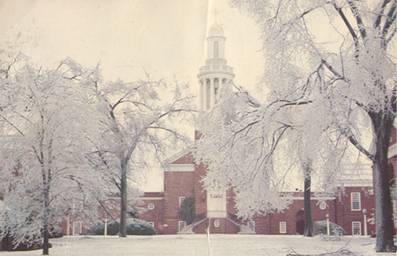
In May in New Haven, I saw a student wearing a simple gold band with Hebrew lettering on it. I ran to my room for a camera, I took a photo of the ring and sent it to Helen. She agreed it was beautiful enough for her wedding, so I went down to New York City to the address given by the ring wearer.
Meanwhile, I wrote a term paper using form critical theory as to a discovery that Hosea was probably using an ancient wedding vow in his prophecy. Professor Brevard Childs, my Old Testament professor at Yale agreed with me. Is this not strange behavior for a bridegroom in a divinity school? At any rate that was the way I got ready for our wedding, in libraries and on trains; meanwhile, Helen and her mother did the major activities of arranging the church, the minister and the reception.
As the day of the wedding approached, my mother and father, three brothers, and two aunts climbed into two cars and drove from North Carolina to Connecticut for the Yale graduation, where both Brother Reid and I got our diplomas. Then we went to New York City to pick up the rings, but the rings were not finished. Alas, the craftsman had somehow assumed I was Jewish, so he put a Star of David on each ring instead of the crosses, which I am sure I had asked him to put there. As a result, we had to wait several hours; and only with the intercession of my aunt Bert did we finally get on the road again. My brother Reid was so angry at the delay of several hours that he uttered the strongest curse that I have ever hear him utter, but his words need not be repeated here.
We arrived safely in Iowa after two more days of travel. soon after we checked into a motel, the pressure of the journey and the compression of so many people in automobiles for so long resulted in a watermelon fight. Such fights were not unknown in our family, and they often commenced with Brother Betts firing a seed at some unsuspecting soul, while not even looking at his target.
But soon chunks of mostly eaten watermelon rinds were being thrown at family members. Our fight was intended only for an internal struggle within the family. No one passing by on foot, in a car or on a tractor was hit, at least to my knowledge. Even my mother participated by hurling a half eaten piece at my father, who was very, very surprised. Usually she tried to stop such fights; but one viewer remembers she seemed to be enjoying this battle.
The only abiding casualty of the struggle was Brother Reid, hit on his right ear. As best man, he could not hear well enough to follow instructions at the rehearsal that night.
A more sinister dimension to this battle scene was the fact that since my soon-to-be- father-in-law had made the reservations, the motel owner had called him and reported the battle. I learned some time later that he was very embarrassed and said, “Why did they do such a thing, is that a part of Southern wedding pre-nuptial ceremony? We are well known in this town, and this will be hard to live down!”
Recently, I discovered that in the day before a wedding in one Hopi Tribe there is a tradition of a battle scene between the family of a bride and the family of her groom. Mud is thrown on each other to work through any hostility or resentment which might subsequently arise. And when the combatants have dirtied each other to their satisfaction, a big conciliatory banquet with eating and drinking takes place. That similar event would one my family might have enjoyed; but alas we might have offended Helen’s family who seemed to be unprepared, especially on her family meeting my family for the first time. A wedding is a public event and such a battle would not standard for the night before a wedding in Iowa in l961.
“A wedding not only united the bride and groom, but it also brought the parent families and their kin together. They had to meet, to see one another and to show that they accepted one another; so the wedding became a feast, a demonstration of social background and resources in respect of food and drink, of clothes, of looks and savoir vivre, whereby the two kins formed two teams in a social game to appreciate one another but not to be out shone by the other team…” (Boalt, 159).
In any case, Helen’s family managed to overlook the report of the watermelon battle, and probably they did not know that Native Americans used combative activities in their wedding celebrations. (cf. below “Weddings around the World”).
After the battle was concluded, we took showers, put on the clothing for the rehearsal, as below:
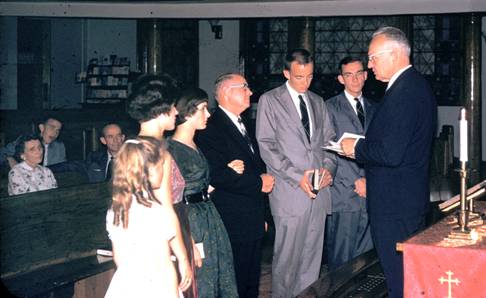
No “professional” pictures were made that day, for the photographer “forgot” to bring any film. He did have a camera, as I remember. His daughter was to play the harp, and we were happy to see that she did not forget the harp. By good fortune, my brother, Betts, brought his 35mm camera, so the images below were scanned from slides hidden in a box for the last 45 years.
Helen looked lovely in her grandmother’s wedding dress as she came down the aisle of the church, and we used our cue cards to give our vows, which we took from the second wedding ceremony of Hosea and Gomer (click “Weddings around the World” then “Wedding of Adam and Eve”).
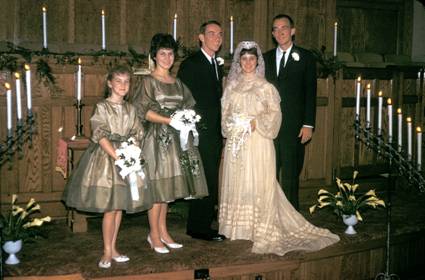
The vow we used was a translation I had made from the Hebrew while writing the term paper mentioned above. We put the lines from Hosea 2 on our rings. Helen’s sisters and my brother Reid all look quite pleased that we had finished the ceremony. The prelude and postlude were played on the harp by a sorority sister of Helen. We remember the “Trumpet Tune” by Purcell as the former.
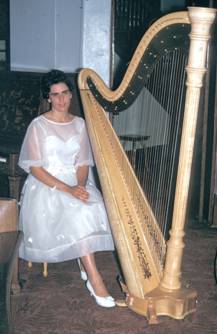
Just before going to the reception at the Rank home, Helen’s mother proclaimed, “God was present at this wedding service.” I was both surprised and pleased. No one had ever before, or in fact since, proclaimed with such conviction the presence of God at any wedding I have ever attended, although some might have felt such a conviction. As soon as the wedding was over and we went to the home of Helen’s parents.
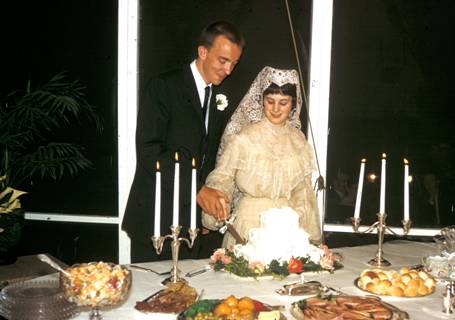
That spread of food was all eaten up by the hungry guests, but perhaps as a precaution of the Rank family, no watermelon was to be found on the table.
Sometimes weddings are followed by attempts of pranksters to steal or at least delay the departure of the vehicles which were intended to allow the recently wed couple to escape to a honeymoon, and of course my brothers would attempt to do so. I was even more troubled by the fact that the wedding license was still in the vehicle, so I went so far as to hide the little VW in a nearby town, thinking those brothers of mine would search out the whole town to find that little car.
We protected the car and the license which was so precious, for I feared without such a document one could not get lodging in a hotel in Iowa, maybe not even buy gasoline to take a woman across a state line! Here below is the official proof of our wedding.
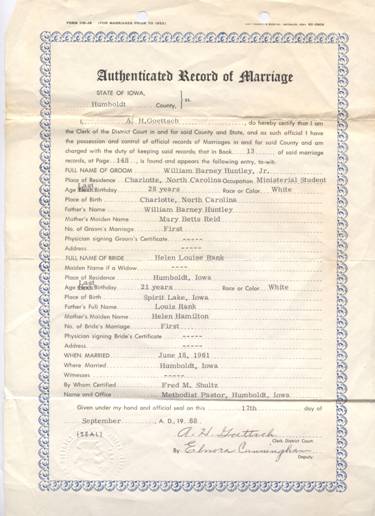
Everyone who contributed to the comments elsewhere in my album gets a chance to add something about what is happening in 2007 or at least to reflect since the time of their weddings. What should I say about Helen and me after 46 years?
Each year we have each listed our favorite book on our Christmas letter. This month Helen is reading Norman Mahler’s novel written from the point of view of Satan as if he inspired Hitler, and I am reading Paul Russo’s Straight Man, about an English department chair in an imagined Pennsylvania public university. Last night (March 22, 2007) Helen asked about my day and then said, “It does not appear you are so much interested in what happened in the wedding ceremonies as to what happened to the people you are connecting with. I think you are just this project to fulfill that need in yourself which allows you to connect with people.” Then she asked if anyone had actually discussed what love is. “What is love which holds people together?” she pondered. Then she reminded me of the musical we have seen several times, “The Fiddler on the Roof.” In it there are three weddings, one for each of the three daughters; somewhere in the story the father asks his wife, “Do you love me?” To which his wife of twenty years responds, “Do you need to ask when I have lived these years with you?”
2. 
Two weeks after our wedding in Iowa, we drove to New England for the July 1, l960 wedding of my friend Phil McKean, who asked me to be the best man in his wedding in Bristol Rhode Island, where his bride, Deborah, had grown up. She had just graduated from Mount Holyoke College in 1961 as Phil had done from Yale Divinity School. Phil was my best friend in those years at Yale, and we had spent the second year of divinity requirements at the University of Edinburgh. Below is our outbound passage from New York, on the Holland-Amerika Line SS Rotterdam.
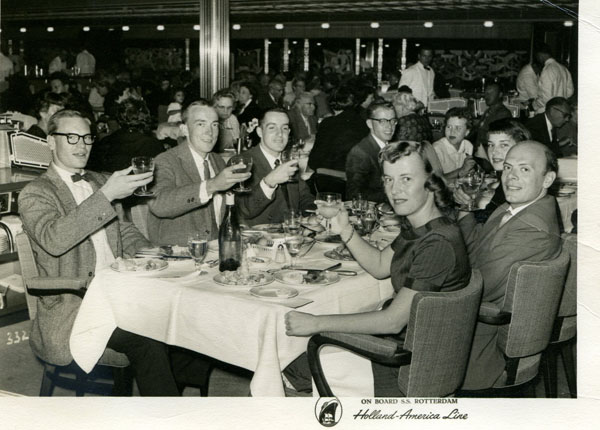
Back to New Haven for the third year, Phil was my guide all over New England while we both lived on the Old Campus at Yale, he served as a freshman adviser and I worked in Dwight Hall, recruiting first year students to do community service in the New Haven area.
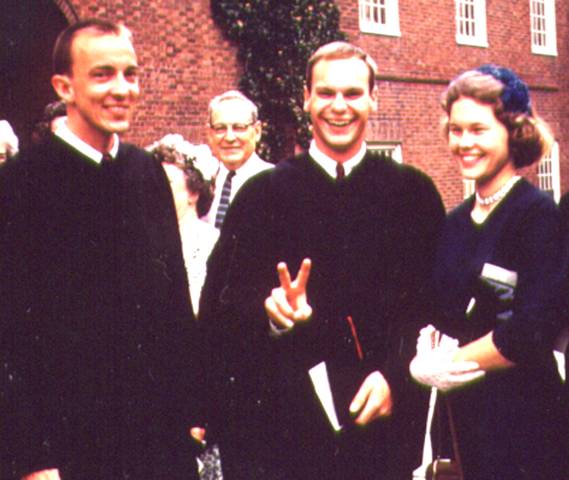
Here we are pictured graduating from Yale Divinity School in l961; Deborah had just graduated as well. Phil’s Dad is smiling in the background. Phil and I had shared many travels by that time, and we have since then.
He came to visit us in Missouri soon after our daughter Heather was born, Helen vividly remembers. We have sailed in Maine, where he is now living, in San Francisco Bay, which he remembers as being very cold. His son lives now in Santa Barbara,CA, where his grandson graduated from high school. Deborah was ordained in 2007 as a deacon in the Episcopal Church; Phil remains a minister in the Congregational Church. They both ski together, he recently told me.
Recently I learned that Phil and Deborah will retire to Pilgrim Place in Claremon, so we will continue our friendship on this coast. Below is a family picture of the MacKeans from 2009.
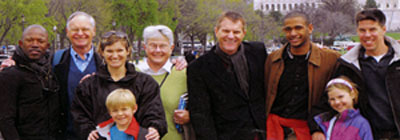
I will supply the names and relationships on demand!
(3)  The weddings of my brothers allowed me to understand from a fresh perspective the character of each of my brothers, for each had a different kind of ceremony. Brother Betts was married in l962 to Martha, who was still a student at Barnard College, but she had managed to work out a plan to live with Betts and attend courses at Queens College in our hometown of Charlotte, N. C. as her senior year at Barnard College In New York City; this happened because of the open mindedness of Barnard’s President, Dr. Millicent McIntosh, who found a creative way to advance the career and marriage of one of his seniors. The weddings of my brothers allowed me to understand from a fresh perspective the character of each of my brothers, for each had a different kind of ceremony. Brother Betts was married in l962 to Martha, who was still a student at Barnard College, but she had managed to work out a plan to live with Betts and attend courses at Queens College in our hometown of Charlotte, N. C. as her senior year at Barnard College In New York City; this happened because of the open mindedness of Barnard’s President, Dr. Millicent McIntosh, who found a creative way to advance the career and marriage of one of his seniors.
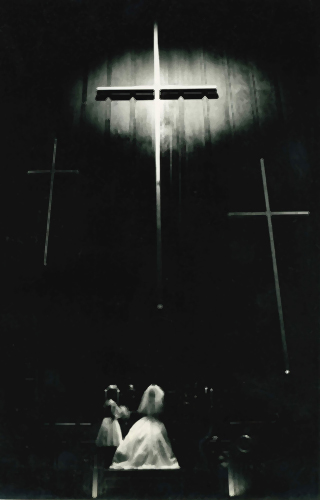
The photograph above captures in an almost mystical manner the sanctuary of Westminster Presbyterian Church in Charlotte, N. C. with the cross on the wall and Martha’s dress which looks a bit like an angel in flight. The setting of their wedding ceremony was in a church built in the l950’s in a modern style, illumined by natural light, with strong “Puritan influences” as there was little iconography in the side windows and only a cross in the nave. Somewhere in the darkness stood Betts with his brothers, but all of us were illumined by the cross. The celebrant was the Rev. Malcolm Williamson, Martha’s home church pastor and third cousin.
Martha recently reported that she remembered the ceremony as having almost the exact words of a service written by our great-grandfather, the Rev. Charles Bowen Betts who served as pastor in the Union Church in Chester County S. C. in the Associate Reformed Presbyterian Synod, where he must have performed more than a mere one hundred weddings. ( I have some of his sermons in beautiful handwriting on paper one-hundred and fifty years old, but I found no wedding sermons. He must have used the ceremony all presbyterians borrowed from Scottish forebears in the 17th Century book of common worship.
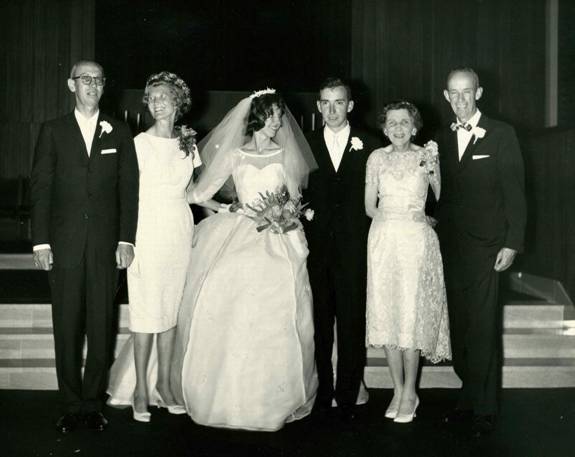
Here Betts and Martha stand, in the center, with Martha’s mother and father on left and our mother and father on the right. But how happy everyone looks in this image! Indeed, they were!
Betts graduated in l961 from Union Theological Seminary in Richmond, Virginia; both Reid and I graduated from Yale Divinity School also in l961. How that could happen is another story, perhaps three separate stories; but in any case all three of us were neophytes with B.D. degrees headed in three different directions. Moreover, we were all unmarried at the time we finished our BD degrees, but within 3 years all three of us would be married in three quite different places.
Betts and Martha have amazingly evolved senses of humor, and their wedding photos of Bill Barley show it.
On the day of his wedding, my brother Betts gave me the official Presbyterian Book of Common Worship with the inscription, “To Bill, on the occasion of my wedding and in thanks for taking part, Betts.” Little did he or I imagine how many times I would use the book in the four decades.
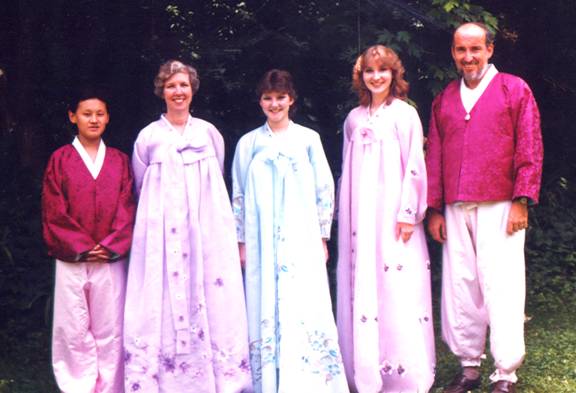
Betts and Martha lived Korea for twenty years, where he taught pastoral theology to ministers in the Presbyterian Church in Korea. He also taught German; but in both fields he taught in Korean, which he managed to master. His family of Michael, Martha, Jennifer, Susan and Betts seem to have taken on Korean garments as well. Missing from the photo is Mary, the eldest, who was then a student at UNC, Chapel Hill.
Upon returning from Korea, Betts served as teaching elder to the Safety Harbor Presbyterian Church in Florida. Now both he and Martha, who retired this spring from her work in the Presbytery Office in St. Petersburg
(4).  Brother Reid’s wedding came next in the line of family weddings of our generation in the Huntley clan. His was held in Williamsburg, Virginia where he was a campus minister working out of the Presbyterian Church there. Reid Married Joy Miller, who was then a graduate student in Political Science and writing about “Roman Catholic Just War Theory as applied to Nuclear War.” Meanwhile she was working in Williamsburg, taking tourists back into the 17th Century on tours. She was particularly interested in the lives of slaves in that time and place, which interests me as well. (For some comments about slave weddings I found an article by Thomas Will (1999) noting the fact that because slaves were considered “property,” they could not enter into legal contracts, as in a marriage. But in fact when married, if not disrupted by being sold to another locale, they were usually faithful to their mates, and the majority of slave owners respected the institution of marriage and allowed, even encouraged, marriage between slaves for economic reasons of religious beliefs. The slaves often imitated the forms of ceremony and even dress, when possible, of their masters. Some wanted preachers to perform their weddings. Brother Reid’s wedding came next in the line of family weddings of our generation in the Huntley clan. His was held in Williamsburg, Virginia where he was a campus minister working out of the Presbyterian Church there. Reid Married Joy Miller, who was then a graduate student in Political Science and writing about “Roman Catholic Just War Theory as applied to Nuclear War.” Meanwhile she was working in Williamsburg, taking tourists back into the 17th Century on tours. She was particularly interested in the lives of slaves in that time and place, which interests me as well. (For some comments about slave weddings I found an article by Thomas Will (1999) noting the fact that because slaves were considered “property,” they could not enter into legal contracts, as in a marriage. But in fact when married, if not disrupted by being sold to another locale, they were usually faithful to their mates, and the majority of slave owners respected the institution of marriage and allowed, even encouraged, marriage between slaves for economic reasons of religious beliefs. The slaves often imitated the forms of ceremony and even dress, when possible, of their masters. Some wanted preachers to perform their weddings.
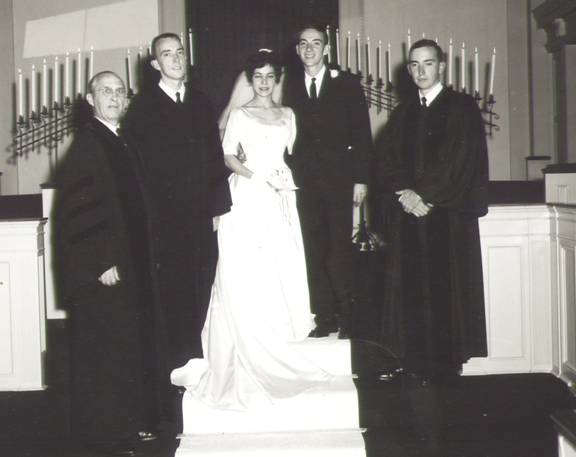
The picture is from the wedding album of Reid and Joy. Dr. Grey, Senior Minister in the Williamsburg Presbyterian Church (left) made the pronouncement, although he looks a little surprised here. I (second left) began the ceremony with the “Gathering Statement” as to why we were all present. Joy and Reid are in the center, and brother Betts (right) who looks a bit sleepy at so many pictures taken after the wedding ceremony. Reid is clearly the happiest person in the photograph; it was his wedding after all; and the build up for the wedding was exhilarating.
Reid and Joy wrote their own ceremony, including their vows. Reid reported recently that in the wedding he conducted for others thereafter, he had the bride and groom do the same, although he provided samples of ceremonies for them to consider.
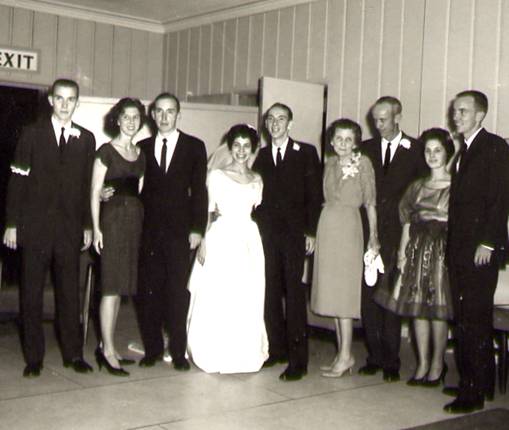
In this picture all four brothers, three wives, and our mother and father, are captured. No other picture of my family captures so many of us or any “exit” sign as on the left.
Joy seems the most joyful person in the picture: Brother John on the left seems to be pondering what he will do with the garter he captured. Brother Betts and his wife Martha beside John on the left side also seem puzzled by what is happening to the left. Only Mom seems looking at the camera, while Dad is looking at her. I seem to be amused, as was Helen my wife.
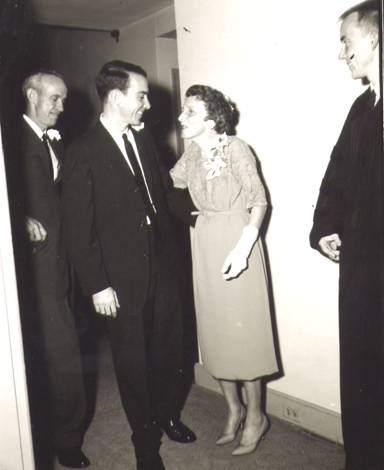
This picture of Mom shows her giving advice to Reid just after the wedding ceremony. Reid remembers her words as typically encouraging, “That was great. We are so proud of you!”
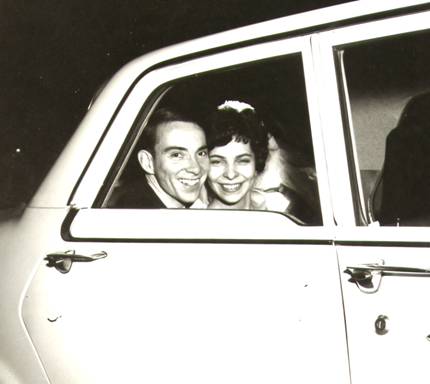
Finally, I love the classic shot of Reid and Joy in the car ready for the “escape” to nearby Virginia Beach. Reid remembers that during their first night there was a tremendous storm with thunder and lightening. From there they went to Philadelphia and to New York City. When they left Williamsburg it was to Chapel Hill, N.C. where Reid completed his Ph. D. in American Literature and Joy hers at Duke. Thereafter, both were appointed to the faculty at Ohio University. Their marriage brought two children into their family as follows: a son, David, who works for Abbot Lab. in Chicago and a daughter, Maria who is herself a mother, with two daughters. Her husband, Roman, designs web sites. They live in Athens, Ohio.
Reid is presently re-married to Marjorie Murray. They now live in Columbus, Ohio. Reid is retired; Marjorie is a counselor in three elementary schools in the Columbus Public School system.
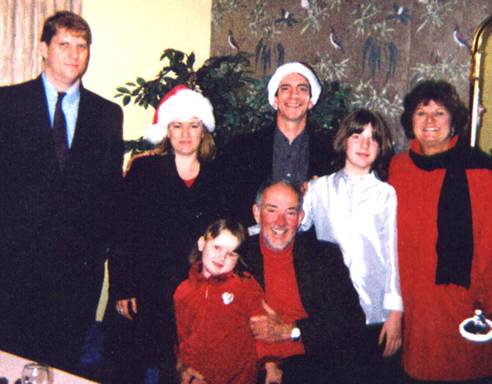
The image above captures Reid’s family in December 2006 with Reid on the front with Jayne, Maria’s daughter. On the back row are Roman, son-in-law; Maria, daughter; David, son; Jessica, Maria’s elder daughter; and Marjorie, Reid’s wife.
(5).  Brother John was married in June 1966 in St. Cloud, Minnesota to Mary Stemm, in her family Lutheran Church and the pronouncement was made by the minister in the church. Since all his brothers were ordained by then, we wanted to have a part in his wedding. Brother John was married in June 1966 in St. Cloud, Minnesota to Mary Stemm, in her family Lutheran Church and the pronouncement was made by the minister in the church. Since all his brothers were ordained by then, we wanted to have a part in his wedding.
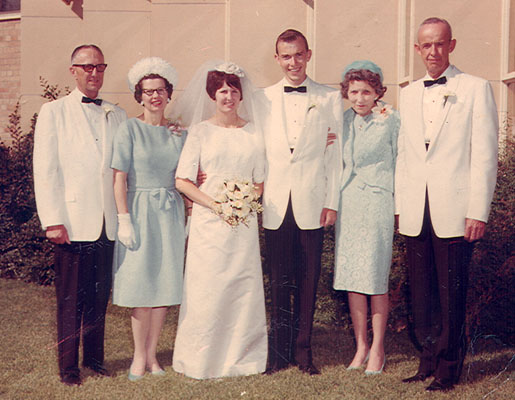
images/johnhuntleymrywed.jpg
Then
a more relaxed moment was captured just after the formal line up with
the picture below, when the
vows had been affirmed and all of us were in a reception line which
led to the food. The happy moment was recorded on film, with both sets of parents wearing almost identical wedding costumes. Not long after the wedding John entered the U. S. Army, teaching English skills and typing at which he was a master, and later going to Vietnam where he became secretary to a general. Upon return from Vietnam he entered the MBA program at San Diego State University.No
pictures of the year in Vietnam were provided, but the year was a
hard one for each of them and when he returned both had changed
greatly, as indeed is the case with many who returned from that
conflict. Mary’s growing objection to the war could not be shared
over the year of separation.
Meanwhile,John’s proximity to the conflict still haunts him
if a car backfires, or if someone approaches too suddenly unannounced
from his”backside.” But on
his last days in the USA as he prepared to leave for Vietnam, in
Southern California he promised himself, if he came back alive, he
would return to San Diego and live.
As one of the lucky ones, he survived. But he knew by name some of the
fifty thousand service persons who were brought back in “body bags.”
Upon return from Vietnam he entered the MBA program at San Diego
State University.
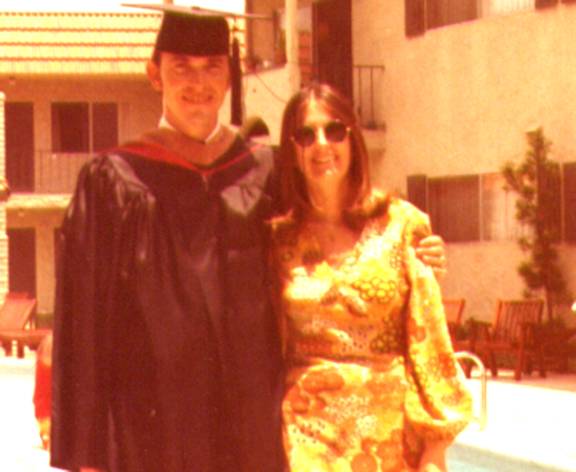
In the picture above John was wearing the cap and gown for his graduation from San Diego State University, where he had received his MBA degree. He worked as a salesman in the San Diego area for twenty years, just as our father had done in North Carolina Mary has served in a number of positions at San Diego State University. Their marriage lasted for 8 years and he remains in touch with Mary, often spending holidays with her. He is now retired from his last job as a activities director for a retirement home in Carlsbad, CA
Brother John was married again in 1979 to Patricia Warfield in the Huntington Library and Garden, where I performed this wedding in the Shakespeare Garden. Wedding are not normally allowed without special permission, and now I hereby confess to the world that this wedding was performed without the permission of the authorities there. Since we were aware that we acting without permission, we did not even consider bringing any musical support.
The ceremony was brief, and it was to have been recorded, but alas, the person in charge of the video camera did not click the right buttons, and after I pronounced them "husband and wife,” the videographer cursed and asked me to do it all over again. I refused and we fled from the sweet smells of the Shakespeare Garden. He and Patti were happily married in San Diego for the next twenty years.
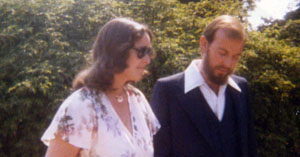
Divorced again, he is on wonderful terms with Patty, and she is often visited by members of the Huntley clan visits during visits to San Diego.
As I wrote about weddings of my brothersI became aware that weddings need not contain a vow that contains no exit. In Jesus time a woman came to him to ponder her fate in the hereafter, and asked which of her husbands would be with her there.
It is just, it is legal, and sometimes it is necessary that some marriages end. But who can see at the time of a wedding that a divorce is ahead? I knew once out of the hundred weddings I performed that the marriage would not last, (Cf. below "Weddings of Faculty" and look for the teddy bear icon.
One more wedding in this section. Yes, I know we are now in the l970's, but for this one just barely. I learned not so long ago that the decade of the "1960's" did not end until the Vietnam War ended.
On April 4, 1970 in Fulton, Missouri in our living room, I
conducted a wedding for my sister –in-law, Deede Rank and Charlie Daugherty. A
diligent reader may find a picture of her already in the Decade of the l960s.
But since that earlier picture, nine years, and she appears in her own green wedding
dress. Charlie drove them down from Iowa, bringing his brother, who almost
seems his twin. All of us are looking toward a "happening to the right" , which
seems to suggest something frightening, at least to me in my black robe. I do not remember what gave me that look of fear, but what caused to look fearful seems to have amused Deede for she is smiling.
.__[GeorgesD]_-_11-10-10_-_EQEDT4L[1]_Page_1.jpg)
Some years pass and a daughter was born during the years
they lived in Iowa, during which both graduated from Simpson College. Shannon brought a contagious smile into every setting where I ever saw her .
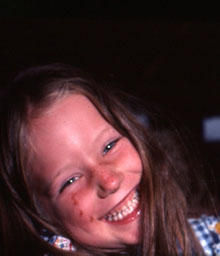
In the same summer that our family moved from Missouri to
California, Deede and her family moved from Iowa to California. We remain indebted to Deede and her family for renting a van, taking it to our house in Missouri, packing up all
our belongings ( I had not imagined when I went to California with a group
of students in April to study Buddhism that I would get at job in Redlands in
May).
Deede and Charlie did a great job of packing our many belongings: but, alas, our books, furniture, clothes, etc.
filled the whole van. Thus Deede called to tell us they needed another van
for their belongings. So, I flew to drive a van full of our possesisons while they all rode in their van in what became one of the
great adventures in life. As the two families moved from the Midwest to California, I remembered “the Grapes of
Wrat," the film version, grateful that we had a place to put down our possessions and new lives at the end of the ride.
Deede came once to visit our house in California in a bright red MG, and she
looked so happy that I never imagined that she was soon to escape California
and move to Wyoming.
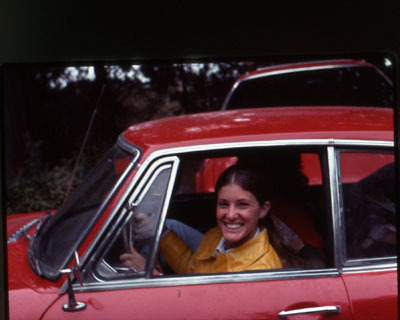
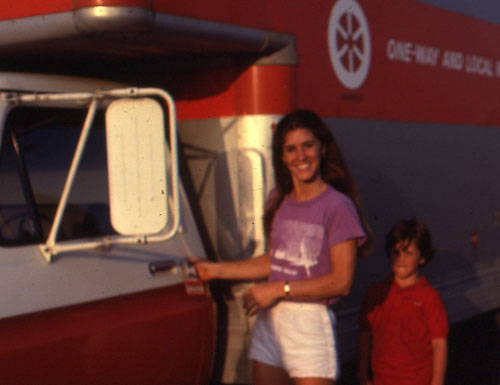
Deede was joined by her daugher Shannon and her son Casey, who was then five years
old, as she made her move to Wyoming , where she has lived ever since.
Actually eight years passed from l974 until l982 when she
made the move, and I know it was in the red car, but the image of her
has lasted in my memory. During those years we shared our Christmas seasons.
Then in January 1981, when I taught a Whitehead class in the evening near
Sherman Oaks, Deede let me sleep on a couch before I headed back to Redlands. I
remember that the next morning when Shannon, who must have been the first person
to get up, was getting ready for school; but looked down at me and asked, “Are
you hungry, Uncle Bill?” When I said, “Yes,” she climbed up on a kitchen
cabinet and got down a box of cereal which she fixed for the two of us to
eat. I should not have been surprised when she left Wyoming for a new career
on the East Coast in a restaurant, even to marry the owner.
Now she has given birth this year to her second child.
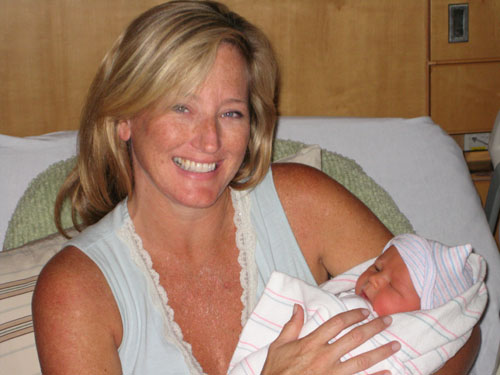
Shannon still has that same wonderful smile, especially after
the delivery of her baby; and I wonder how long it will be until she takes up a
new career in the film industry; but in any case she reminded me of the passing
of a generation since this segment of my “album project” began.
The image below is of Deede's second family, which like the "Brady Bunch" includes her husband Ed Georges and his two sons, along with Casey and Shannon. They are at the W Hotel where Tom worked, celebrating Casey's graduation for getting his Master's Degree in Counseling. Both Tom and Casey live in Scottsdale. All seem happy celebrating that achievement. I recalled the first time Casey at about age 3 saw our horse- Molly (cf. "Decades" "l974..." for a picture of Molly). He said, "BIG DOG!" It seems obvious that he would have a lot of fun in language-development!
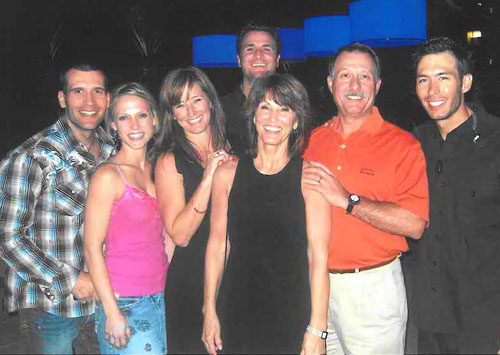
They are as follows: Kevin Georges, his wife Lindsay, Shannon, Casey behind his mom, Deede, Ed Georges, and Tom Georges.
|